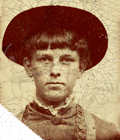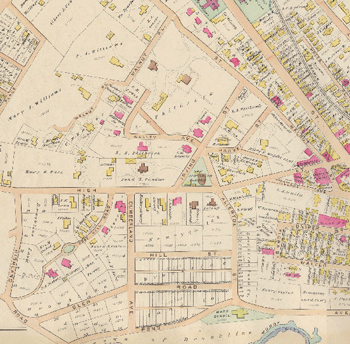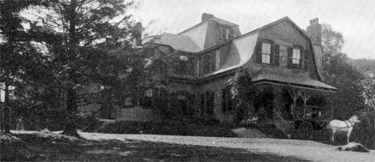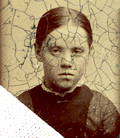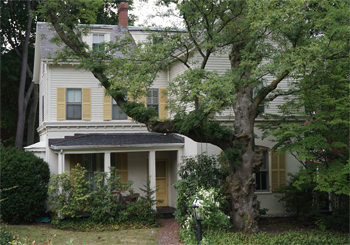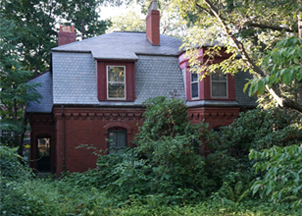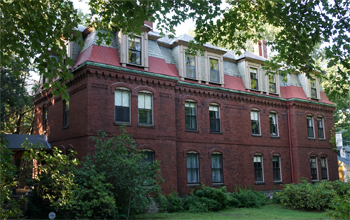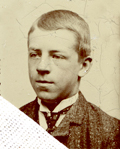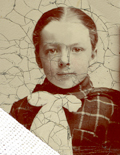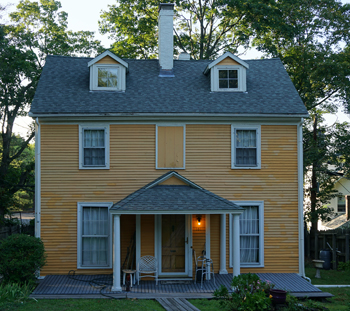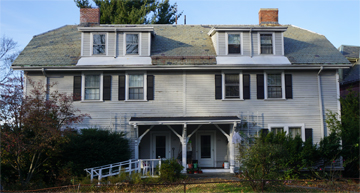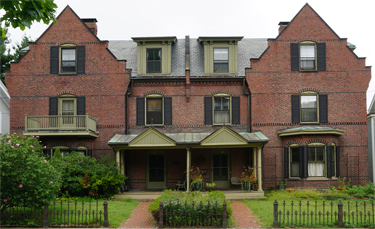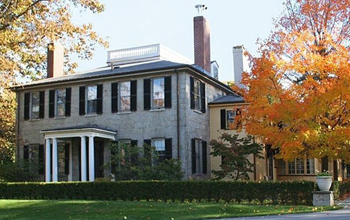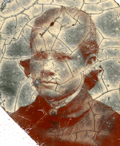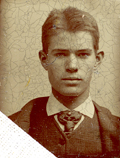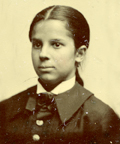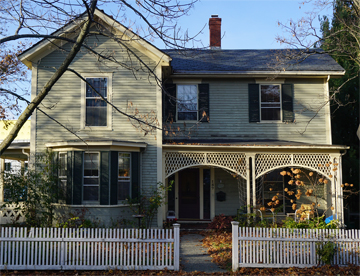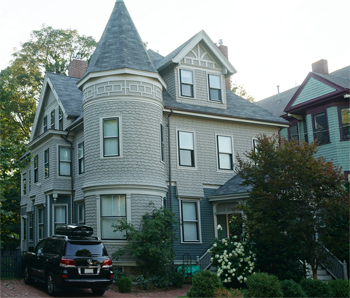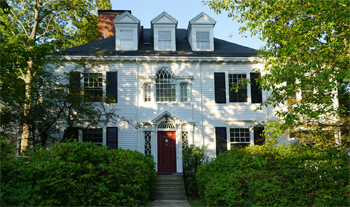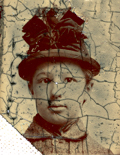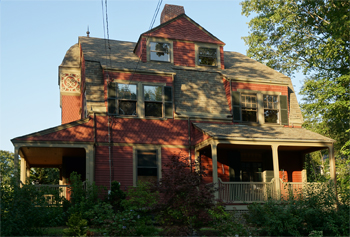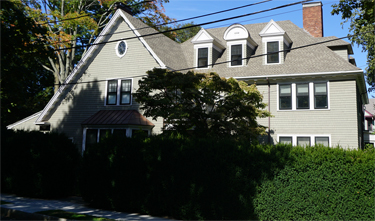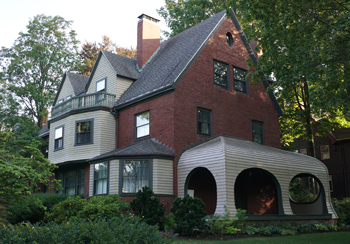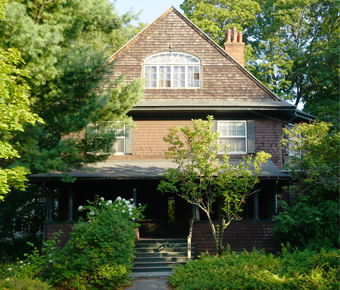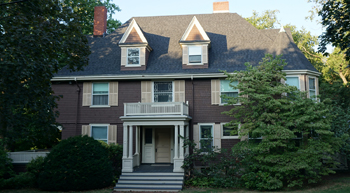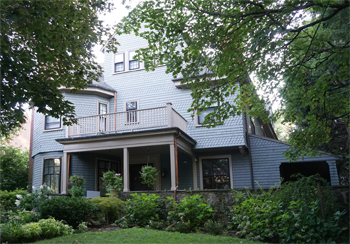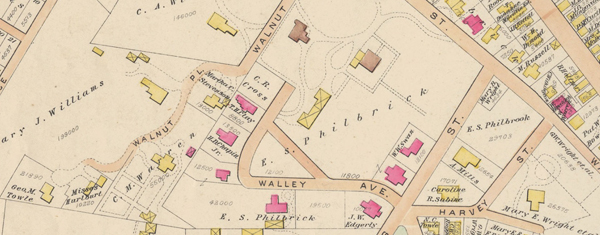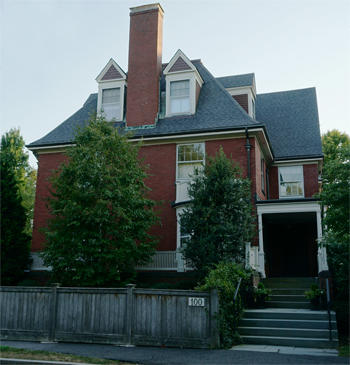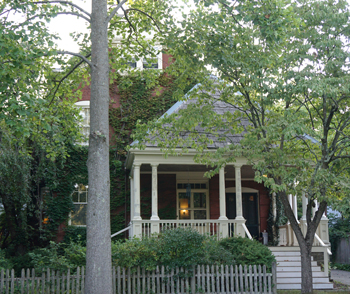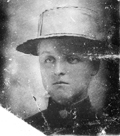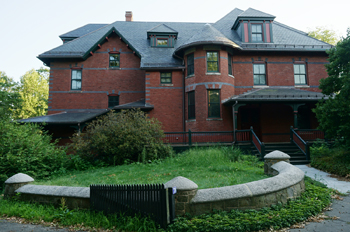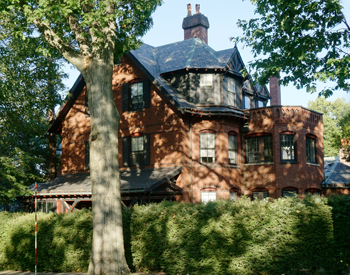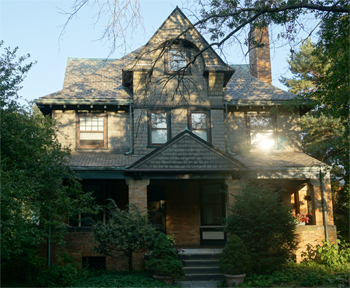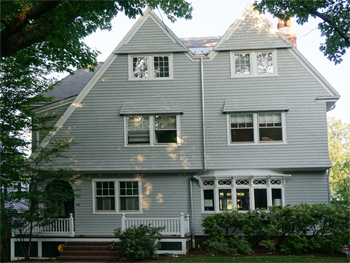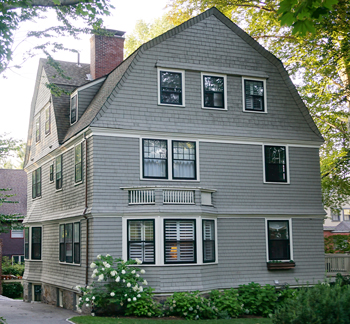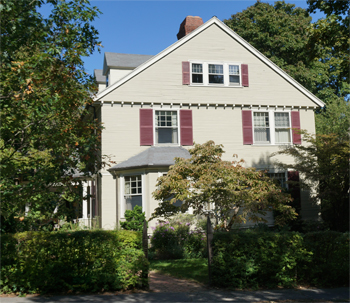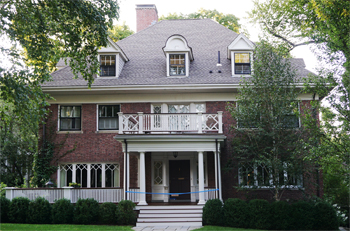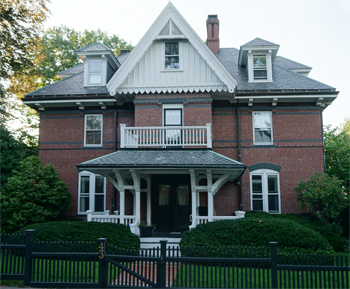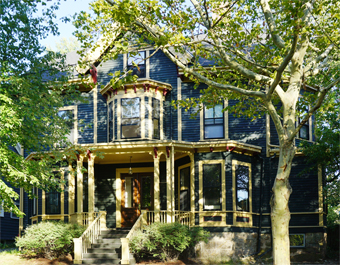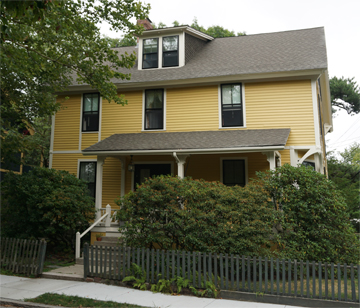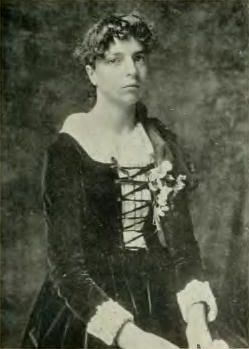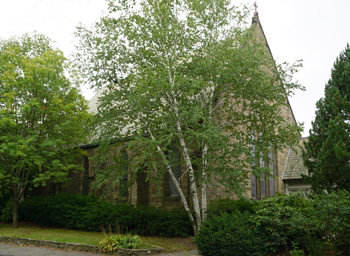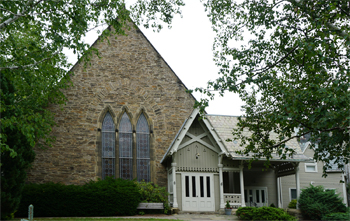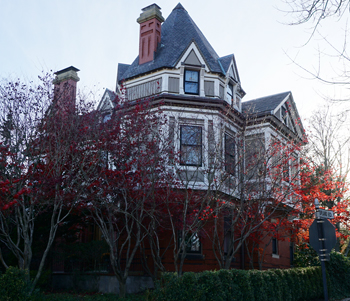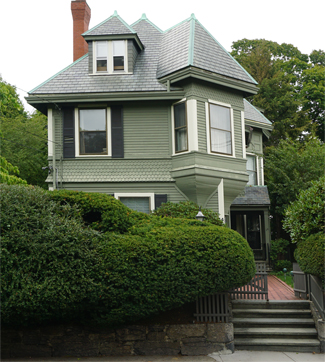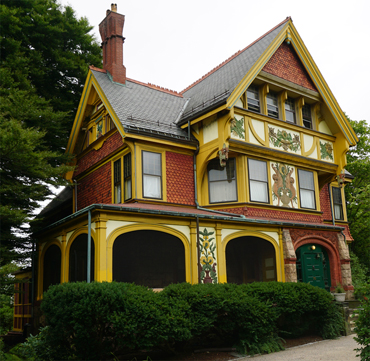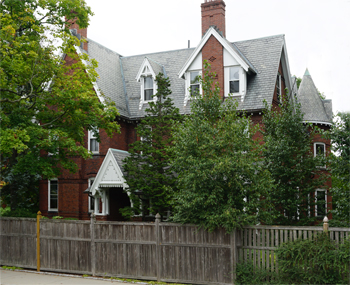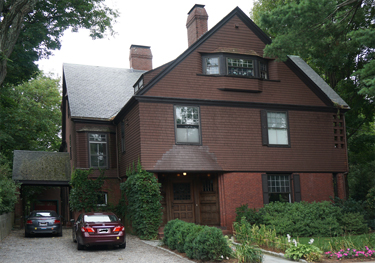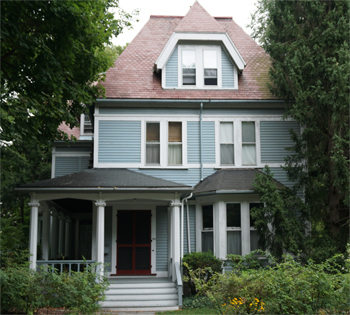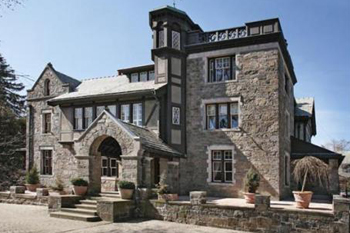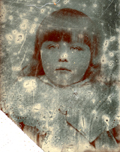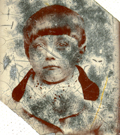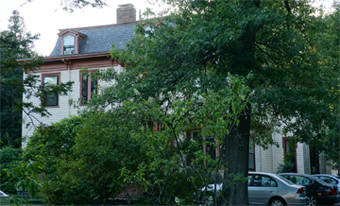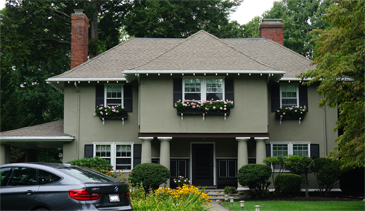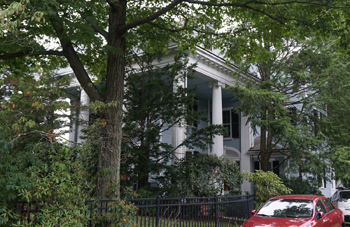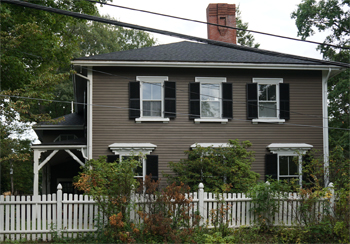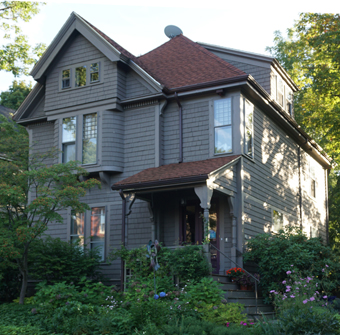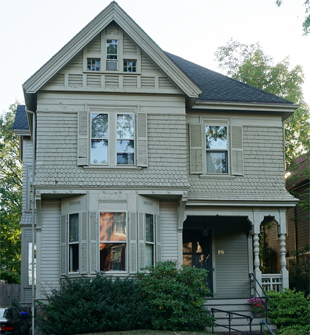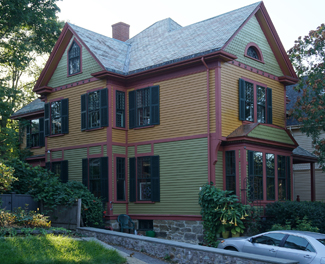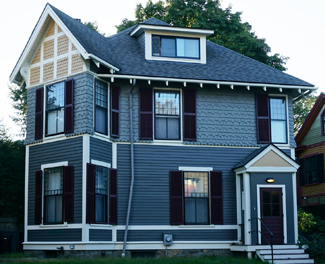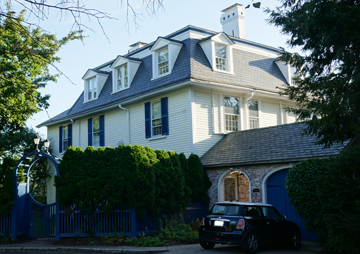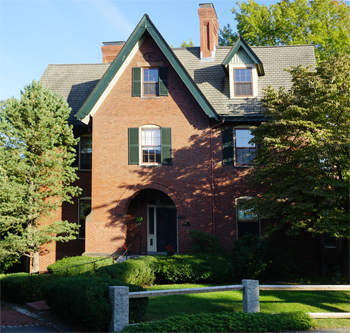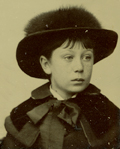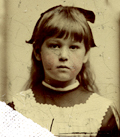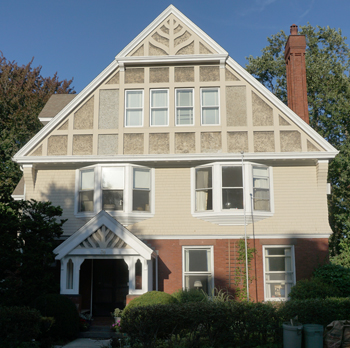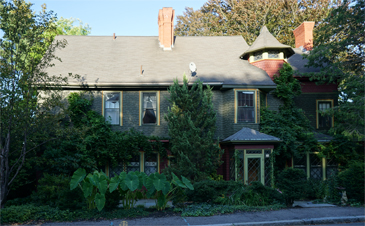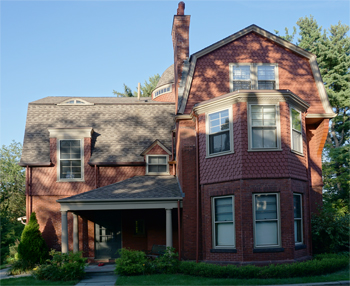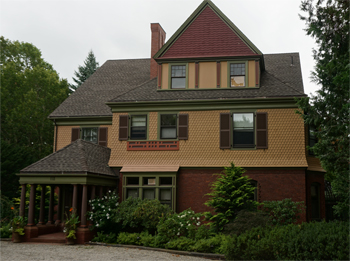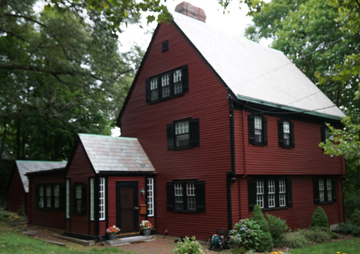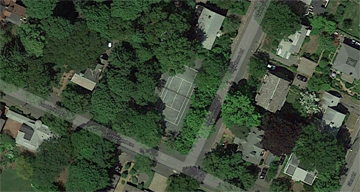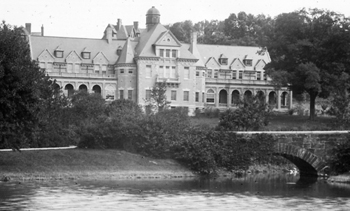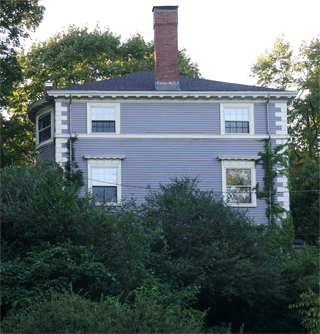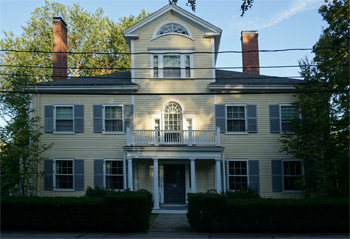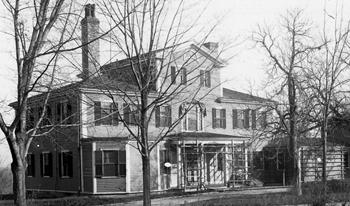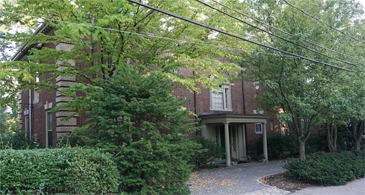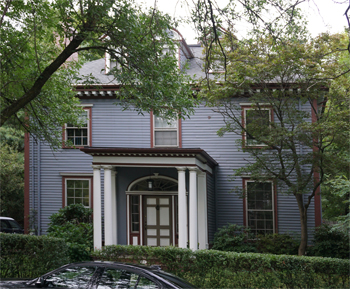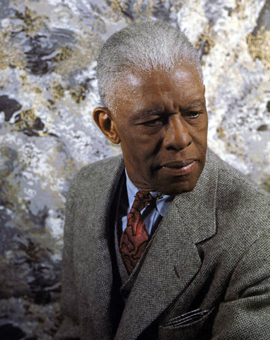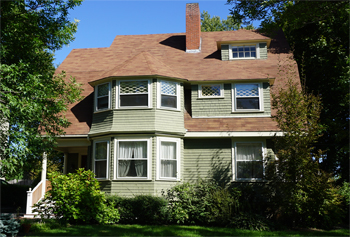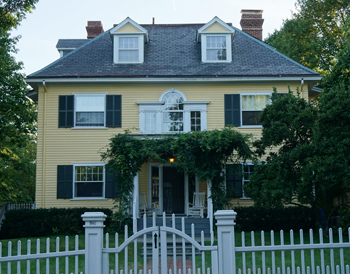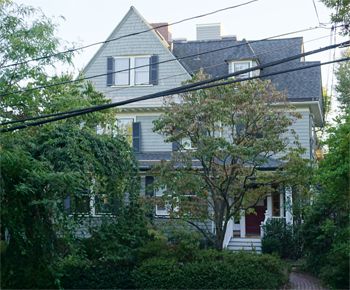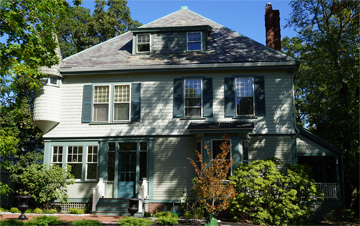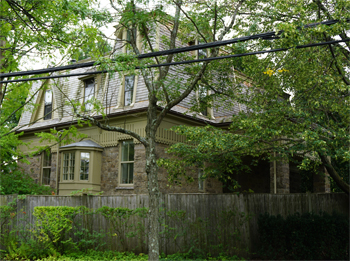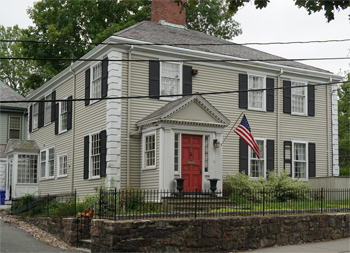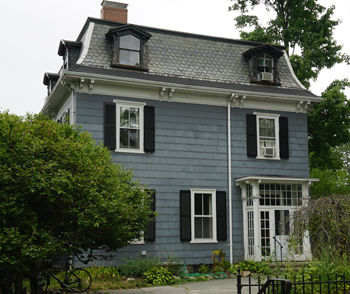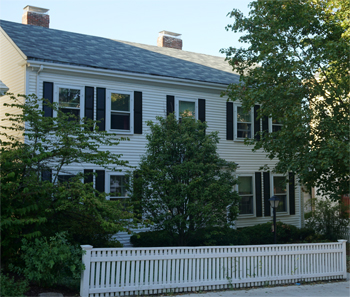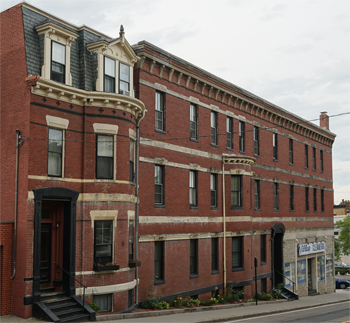Walking Tour: Pill Hill (with the Children of 1886)
This is a reproduction and updating, by permission of the Brookline Preservation Commission, of the Pill Hill section of their 1977 publication Brookline Village: Walking Tours, an architectural guide prepared under the direction of architectural historical Margaret H. Floyd.
The tour has been updated and augmented with images and information from several sources:
The tour has been updated and augmented with images and information from several sources:
- New photos of all of the houses on the tour, taken in 2015 by the Brookline Historical Society
- Additional information about the neighborhood from the 2009 Brookline Preservation Commission publication The Pill Hill Local Historic District: The Story of a Neighborhood, posted on the High Street Hill Association web site.
- Photos of neighborhood young people from an 1886 photo album together with biographical information about them and their families researched and written by the Brookline Historical Society. The photo album, from the collection of the Society, was compiled by Ethel Stanwood, then age 13, who lived at 76 High Street.
- Supplemental editor's notes.
- An introduction to Village architecture
- A tour map with indexed locations.
Introduction
With the 1844 annexation of Roxbury land between High Street and the Olmsted Green Belt, the opening of the Brookline branch of the Boston and Worcester Railroad in 1848 and a shift in the Town's center to the Village area in the 1840s, the development of Pill Hill was imminent. Originally known as High Street Hill, Pill Hill was so-nicknamed in the late nineteenth century because of the large number of medical professionals who lived on the richly-landscaped hillside. Set above the Village and the Point, the neighborhood is particularly distinguished by the numerous examples of Victorian architecture. There is an underlying harmony of size and scale as well as a consistency of good design and workmanship.
A Little History1
The story of Pill Hill begins with Walnut St. It was laid out by 1658, as part of the Sherburne Rd. However, there is a reference as early as 1633 to the construction of a cart bridge over the Muddy River and the road probably followed an ancient Indian trail. The Sherburne Rd. crossed Mission Hill from the Boston Neck and then followed in turn what is now Huntington Ave., the lower portion of Washington St., (only later part of the Worcester Turnpike — now Route 9), Walnut St., and Heath St. (the eastern part of which was also subsumed into the Turnpike). As the first westward route from Boston, the Sherburne Rd. played an important role in the earliest history and development of Brookline and New England. It passed through Brookline’s original Town Center where the first 1714 Meetinghouse stood, at approximately 353 Walnut, on part of a lot later long occupied by the 1856 First Parish parsonage.
The particular character of Pill Hill derives from four significant factors. First, most of its development was carefully controlled by neighborhood residents. Second, its development and landscaping often reflected a respect for the local physical features. Third, many property owners hired well-established, respected architects and land-planners who created a visually harmonious neighborhood of distinguished houses. Fourth, and most important, occupying many of these homes during the nineteenth and twentieth centuries were leaders in politics, education, science, the arts, and, of course, medicine. The name Pill Hill derives from the many doctors who lived here beginning in the late nineteenth century and from the neighborhood’s Free Hospital for Women. As the alternate name, High Street Hill, could not have been used before 1860, it is not clear what the hill might have been called earlier.
...
In size, the early nineteenth century estates were typical of the country properties of the first generation of wealthy retired merchants and carriage-commuters who settled in Brookline. Today we think of suburbs as developing on open farmland, but Brookline was different. In the mid-nineteenth century, when Brookline’s suburbanization and urbanization began, most of northern and central Brookline was compact country estates of perhaps five or ten acres, each with a substantial house and a few out-buildings. (For a time in the late nineteenth century, Brookline was said to be the wealthiest town in the country.) A critical difference between Pill Hill and many areas of Brookline is that, to a large extent, the land owners were their own developers and they intended to stay in the neighborhood. (The same might be also said of a few other Brookline areas, such as Longwood, Cottage Farm, and Fisher Hill.)
The Philbrick Family: Builders and Abolitionists
[Editor's Note This section highlights the house of Samuel Philbrick, the well-known abolitionist who lived at 182 Walnut St., and the houses (numbers 157-205 Walnut and numbers 43, 70, 78 and 94 Upland Road) developed and owned by his son, Edward Philbrick.]
[1] The tour begins at the corner of Walnut Street and Walnut Place where one views number 24 Walnut Place (formerly 204 Walnut Street), a simple 1 1/2 story Second Empire style building with its dormered steep roof and solid stone massing2. The puddingstone, mansard-roofed house was possibly built as a wedding present for Edward Philbrick and remained part of the estate throughout the Philbrick’s tenure. After World War I it doubled briefly as a convalescent home for service men. It was modified in 1939 by the removal of its gambrel roofed front wing, after there had been an initial application for demolition of the whole house. The timing suggests it may have been damaged in the great hurricane of 1938. The wife of Edward Philbrick was Helen Winsor. 204 Walnut Street was the long-time residence of her brother, Alfred Winsor, Jr. and his wife Linda (Kennard) Winsor. Her father, a Civil War veteran, was the president of the Boston Towboat Company and the Boston & Philadelphia Steamship Company. Her maternal grandfather, Martin P. Kennard, was a jeweler, customs house collector, and sub treasurer of the United States in Boston. His home at 25 Kennard Street is now the Brookline Music School.
- Their youngest child was Margaret, pictured here. In 1903 she married Charles Collins, a prominent architect with the firms Allen & Collens and Allen, Pelton & Collens. Among their designs were the Cloisters and the Riverside Church in New York, the Lindsey Chapel of Emmanuel Church in the Back Bay, and the Newton Town Hall and War Memorial.
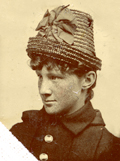
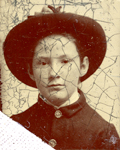
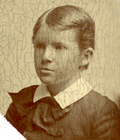
Left: Gertrude Flint (1886, age 15)
Middle: Sarah (Sarita) Gore Flint (1886, age 12)
Right: John Flint (1886, age 10)
Middle: Sarah (Sarita) Gore Flint (1886, age 12)
Right: John Flint (1886, age 10)
- Gertrude (1870-1917) was born in Oregon where her father was working on a project for Northern Pacific Railroad. She married Charles W. Townsend in 1891 at the First Parish Church on Walnut St. Her younger sister, Sarah, was the maid of honor and Roger Tileston (who lived a few houses away across the street) and Henry Ware (who lived next door at #195) were ushers. The couple lived on Marlborough St. in the Back Bay and Gertrude died early, in 1917.
- Sarah (1874-1924) was born in Peru where her father was working on a project there. She was an artist who worked in pyrography, decorating wood or leather by burning a design on the surface with a heated metallic point, and Assistant in Charge of the Textile Collection of the MFA where she worked from 1905 to 1923. She lived with Gertrude and Gertrude's husband and, when Gertrude died in 1917, Sarah and Dr. Townsend married.
- John (1876-1911) was born in Peru when his father was working on a project there. He graduated from Harvard Medical School in 1903 and also died early, of pneumonia, in 1911.
[2] Circa 1871 Edward Philbrick constructed the two brick mansard buildings at 195 and 187-189 Walnut Street which have corbelled brickwork similar to the Panel Brick commercial buildings in the Village.
Charles Pickard Ware and his wife, Elizabeth Lawrence (Appleton) Ware, lived at 195 Walnut in the 1880s. Charles Ware, a music transcriber and educator, was an abolitionist who worked with freedmen in Port Royal, part of the areas of South Carolina controlled by the Union Army. He later contributed to the publication of Slave Songs of the United States.
- Their daughter, Mary Appleton Ware (1877-1968), married Malcolm Cunningham Ware (unrelated, but same last name ).
- Her brother, Henry Ware(1871-1956), graduated from Harvard College in 1893 and from Harvard Law School, married Louisa Fuller Wilson in 1898, and joined the law firm of Storey and Thorndike.
[3] The clapboard farmhouse at 181 Walnut Street, predating 1806, is a simple box-like structure with later additions of dormers and the front entryway. A longstanding neighborhood myth, apparently unsupported by evidence, had this house linked to the Tappan-Philbrick house by a tunnel, a literal-minded
embodiment of the Underground Railroad.
[4A] 173-175 Walnut Street is a clapboard house with Stick style articulation and half-hipped side gables built for Edward Philbrick. Roger Tileston (photo under 5A) lived here in 1898, in the year of the death of his father, and had lived across the street on the Corner of Harvey and Walnut 10 years earlier. Later, Phillips Ward Page, an aeronautical pioneer, lived there. He received his pilot’s license in 1911, became a flight instructor for the Burgess Aeroplane Co. in Marblehead, the aviation editor of the Boston Herald, and took the first moving pictures of Boston from the air. He died in 1917, aged 32, when his navy seaplane crashed in the English Channel.
[4B] 167-169 has Panel Brick detailing with stepped front gables, stick work, tar-dipped brick string courses and segmental arches, and was designed by Cabot & Chandler for Edward Philbrick. Helen Hopekirk, a Scottish-born virtuoso pianist and composer whose performances contemporaries compared to Clara Schumann’s, lived at 169 Walnut and taught at the New England Conservatory after she decided to settle permanently in the Boston area in 1897.
[5]
Across the street, visible from the entrance to its driveway, the Tappan-Philbrick estate at 182 Walnut Street is set back on a gently rising and heavily landscaped hill. Built in 1824-25 for John Tappan, it is one of the oldest homes on the Hill and was originally 18 acres. Typical of the Federal style are the axial symmetry, five bay fenestration, low-hipped roof with balustrade, and four tall chimneys. The granite from the Rockport quarries was an unusual facade treatment, even in its time. In later years wings were added to the right side and rear of the building. Equal in importance to the architectural features is the building's historical significance. Tappan's affairs were caught up in the depression of 1826 and, in 1828 John Tappan sold the estate for about $14,000 to merchant William Ropes, who sold it, in turn, to Samuel Philbrick, Edward Philbrick's father in 1829. At its largest, the Philbrick Estate included everything on both sides of Walnut between Irving and Walnut Place, as well as half of the old Lincoln School site and all of what is now Maple St. and Upland Rd. above Irving.
Samuel Philbrick, a birthright Quaker, and his wife were among Brookline’s leading and earliest abolitionists and financial backers of William Lloyd Garrison’s The Liberator. The Grimke sisters, the Quaker-convert daughters of a South Carolina slave holding family, who were part of the more radical women’s-rights branch of the abolition movement, stayed in the house during the winter of 1836-37. One of Brookline’s first anti-slavery meetings was held there at that time — when a public hall probably could not have been obtained for such a meeting. It was a ladies-only event, but reportedly the poet and ardent abolitionist John Greenleaf Whittier listened from inside a closet. At about this time the Philbricks, at the suggestion of Wendell Philips, took a young black girl into their house as a domestic. They brought her with them to Sunday service at First Parish and had her sit in their pew, rather than in the balcony with the other black servants. As a result they were snubbed, they withdrew from the parish, and eventually helped establish Pill Hill’s Swedenborgian Church. The Tappan-Philbrick house is recognized as a part of the Underground Railroad, although its role in the abolitionist cause was far more longstanding and significant than its connection with the escape of two famous fugitive slaves (William and Ellen Craft) would suggest.
Edward Southwick Philbrick, Samuel’s son, graduated Harvard in 1846 and became a civil engineer, working on such projects as the Hoosac Tunnel through the Berkshires (the Big Dig of its day, linking Boston and eastern Massachusetts with Albany and the West), and on the foundation designs of the Boston Public Library and Trinity Church. Later he became an expert in water supply (designing Brookline’s first system) and sanitary engineering, and a member of the M.I.T. Corporation. His, in at least one instance, architecture partner, William Ware, was M.I.T. ’s first professor of architecture. Philbrick was also briefly a Brookline Selectman and provided expert testimony at the inquiry into the Great Boston Fire of 1872.
An active abolitionist like his father, Edward Philbrick led a venture which purchased one third of Union-occupied St. Helena Island S.C. in 1863 and set out to develop the "Free Labor Cotton Company" which hired freedmen to operate thirteen plantations. After the war, the land was divided and sold mostly to freedmen at below market rates. The "Philbrick Experiment," as it is now called, showed that southern freedmen could be integrated into the free labor market and then it allowed them to buy farms totaling over 4,000 acres — something local white landowners would not have allowed at any price. However, it should be noted that many of the 70 investors were cotton mill owner or cotton brokers. One of the ironies of New England’s support of abolition is that the insatiable demand of its cotton mills sustained the institution of slavery in the decades before the Civil War. It should also be noted that Philbrick’s "experiment" netted his backers a handsome $80,000 — something like a 60% return on their investment — probably due in no small part to the low price originally paid for the land.
Samuel had died in 1859. (His grave is under a slab in the Old Burying Ground.) Edward inherited the estate and began to develop it. He and then his heirs, who later commissioned a subdivision plan from Fredrick Law Olmsted, Sr. in 1889, became one of Pill Hill’s two primary developers, having laid out the upper portion of Upland Rd. and Maple St., building at least ten houses on those streets and Walnut St., and platting at least thirty building lots, in addition to the family’s role in the design and construction of the Swedenborgian church. Edward Philbrick’s widow died, aged 88, in 1922, leaving the house and grounds to Harvard, which promptly sold it for $16,000. One subsequent owner was the Rt. Rev. Anson Phelps Stokes Jr., Episcopal Bishop of Massachusetts. The estate is now protected against sub-division and further development by a preservation easement, generously granted by its present owner.
[Editor's Note see Dr. Walter Burrage's fascinating account from the Historical Society proceedings of 1949 of Samuel Philbrick's early and then-controversial actions in support of abolition.]
Samuel Philbrick, a birthright Quaker, and his wife were among Brookline’s leading and earliest abolitionists and financial backers of William Lloyd Garrison’s The Liberator. The Grimke sisters, the Quaker-convert daughters of a South Carolina slave holding family, who were part of the more radical women’s-rights branch of the abolition movement, stayed in the house during the winter of 1836-37. One of Brookline’s first anti-slavery meetings was held there at that time — when a public hall probably could not have been obtained for such a meeting. It was a ladies-only event, but reportedly the poet and ardent abolitionist John Greenleaf Whittier listened from inside a closet. At about this time the Philbricks, at the suggestion of Wendell Philips, took a young black girl into their house as a domestic. They brought her with them to Sunday service at First Parish and had her sit in their pew, rather than in the balcony with the other black servants. As a result they were snubbed, they withdrew from the parish, and eventually helped establish Pill Hill’s Swedenborgian Church. The Tappan-Philbrick house is recognized as a part of the Underground Railroad, although its role in the abolitionist cause was far more longstanding and significant than its connection with the escape of two famous fugitive slaves (William and Ellen Craft) would suggest.
Edward Southwick Philbrick, Samuel’s son, graduated Harvard in 1846 and became a civil engineer, working on such projects as the Hoosac Tunnel through the Berkshires (the Big Dig of its day, linking Boston and eastern Massachusetts with Albany and the West), and on the foundation designs of the Boston Public Library and Trinity Church. Later he became an expert in water supply (designing Brookline’s first system) and sanitary engineering, and a member of the M.I.T. Corporation. His, in at least one instance, architecture partner, William Ware, was M.I.T. ’s first professor of architecture. Philbrick was also briefly a Brookline Selectman and provided expert testimony at the inquiry into the Great Boston Fire of 1872.
An active abolitionist like his father, Edward Philbrick led a venture which purchased one third of Union-occupied St. Helena Island S.C. in 1863 and set out to develop the "Free Labor Cotton Company" which hired freedmen to operate thirteen plantations. After the war, the land was divided and sold mostly to freedmen at below market rates. The "Philbrick Experiment," as it is now called, showed that southern freedmen could be integrated into the free labor market and then it allowed them to buy farms totaling over 4,000 acres — something local white landowners would not have allowed at any price. However, it should be noted that many of the 70 investors were cotton mill owner or cotton brokers. One of the ironies of New England’s support of abolition is that the insatiable demand of its cotton mills sustained the institution of slavery in the decades before the Civil War. It should also be noted that Philbrick’s "experiment" netted his backers a handsome $80,000 — something like a 60% return on their investment — probably due in no small part to the low price originally paid for the land.
Samuel had died in 1859. (His grave is under a slab in the Old Burying Ground.) Edward inherited the estate and began to develop it. He and then his heirs, who later commissioned a subdivision plan from Fredrick Law Olmsted, Sr. in 1889, became one of Pill Hill’s two primary developers, having laid out the upper portion of Upland Rd. and Maple St., building at least ten houses on those streets and Walnut St., and platting at least thirty building lots, in addition to the family’s role in the design and construction of the Swedenborgian church. Edward Philbrick’s widow died, aged 88, in 1922, leaving the house and grounds to Harvard, which promptly sold it for $16,000. One subsequent owner was the Rt. Rev. Anson Phelps Stokes Jr., Episcopal Bishop of Massachusetts. The estate is now protected against sub-division and further development by a preservation easement, generously granted by its present owner.
[Editor's Note see Dr. Walter Burrage's fascinating account from the Historical Society proceedings of 1949 of Samuel Philbrick's early and then-controversial actions in support of abolition.]
[5A] House indeterminate.
John Boies Tileston and Mary Wilder (Foote) Tileston and their children lived in Brookline from May 1885 to January 1889. The exact location of their house is currently unresolved. The city directories list the address as Upland Ave. (then Harvey St.), corner of Walnut St. yet the 1888 Atlas shows no structures at that location. It is our speculation that they lived in one the houses on Walnut owned by Edward Philbrick. John Boies Tileston was in the Harvard class of 1855 with Edward's younger brother, William Dean Philbrick. His son, Roger Tileston, pictured here, later lived at 173 Walnut, a Philbrick house.
- Roger Tileston (1869-1922) was a principal in Tileston and Hollingsworth, a paper manufacturer located in Hyde Park, and continued in that industry among several other firms. He was an usher at the wedding (First Parish Church, Walnut St., 1891) of Gertrude Flint, who lived close by at 205 Walnut St. He graduated from Harvard in 1891, which time the family had moved to Milton, which also would have been reasonably close to the main paper mill on the Neponset River. He married in 1897, then moved, in 1898, to 173 Walnut St., the year his father died. His mother moved to 71 Marlborough St. in the Back Bay and Roger spent 1900 - 1903 at 33 Edgehill Rd.
- His younger sister, Amelia(1872-1920), attended "Miss Baker's" school, later studied nursing, and worked in her life, apparently tirelessly, to aid people who were suffering. She traveled the world to this end and, in 1916, returned from Europe to her mother's house at 43 Allerton St., consumed by wanting to aid the beleaguered Serbian refugees from WWI. She went to Serbia and worked for the Red Cross but died there, of pneumonia. Her work is detailed in the book "Amelia Peabody Tileston and her Canteens for the Serbs".
[5B] [Editor's Note While most of the children featured on this page come from Ethel Stanwood's 1886 photo album, we are including a couple, like this one, from the 1882 photo album of another Brookline girl, Mary Williams.] In 1877, New Yorker Jotham William Post died while sailing across the Atlantic. His wife, Eliza Dwight (Chapman) Post, and their two children moved into the house of her mother (Lucinda Dwight Chapman) on "Walnut St. nearly opposite Irving" which is most likely 157 Walnut, built and owned by Edward Philbrick. Her daughter, Eliza (same name), is pictured here in 1882 at the age of 15. The whole family moved to 12 Upland Rd. circa 1894.
[6] Turning the corner onto Irving Street (laid out in 1870), one passes examples of varied architecture from the 1880s and 1890s. At 9 Irving Street is a Queen Anne style structure designed in 1890 by George Moffette, Jr. Queen Anne elements visible in the verticality of the complex roofline are combined with Stick style paneling on the corner tower and in the dormer window. Interestingly, Moffette, along with many other Boston design professionals, had once signed a manifesto saying that they would adopt the metric system on July 4th, 1876! This house was built for, and for many years owned by, Dr. E.F. Vickery a prominent surgeon and author of medical texts. He never lived there. It was first occupied by Elias Bliss, a flour merchant, and then by Dr. David Townsend, a leading TB specialist, who eventually owned it.
[7]
The north side of Irving was part of the Wright Estate. 14 Irving St. was designed in 1895 by Julius Schweinfurth in the Georgian Revival style. Upright and box-like, its shallow hipped roof is barely seen behind the three pedimented dormers. The three bay clapboard facade bounded by Ionic pilasters and dentils at the eaves focuses on an ornate entrance with tracery in the sidelights and fanlight, as well as in the Palladian window above. Herbert B. and Sara R Ehrmann lived here. It is typical of the progressive and diverse character of Pill Hill that he was one of Sacco and Vanzetti’s attorneys. She, already a feminist and suffragist of long standing became, at 33, a leader of the Massachusetts Council for the Abolition of the Death Penalty which, after a decades-long struggle, succeeded in ending the death penalty in Massachusetts. She also was a founder of the League of Women Voters in Brookline.
[8]
Arthur Mills, an executive of the Boston & Albany Railroad, hired Peabody & Stearns to design 22 Irving St. (1883), a wonderful Shingle Style house that looks as if it had been miraculously transported from a summer isle in Maine. It is sheathed in clapboards and six different shingle designs with graceful strap work on its side tower and a sweeping rear roof and front gambrel.
Parents, Arthur Mills and Jennie May (Barrett) Mills, lived here into the 1900s.
- Pictured here is their daughter, Eliza (1867-1919). She married, in 1901, Philip Yardley De Normandie.
Popular in the 188Os and 1890s, the Shingle style was developed in New England by many of the architects who designed houses on Pill Hill, including William Ralph Emerson, Peabody and Stearns, and Arthur Little. The style was an assimilation of Colonial Revival and Queen Anne influences adapted to the growing interest in informal, suburban living. There was a new sense of openness, with the strong emphasis on a harmonious relationship between the building and its environment. It is an architecture in which the framing is concealed by a tight sheathing of wood shingles in an organic, naturalistic fashion. As such, the Shingle style represents the ultimate reaction against the structuralism of the Stick style and the textural variety of the Queen Anne style. Complementing this skin-like surface, windows often form horizontal bands; verandas become an integral part of the main building and hug the ground. Although classical details can be found on some later Shingle style buildings, decoration is usually kept to a minimum.
[9] On the corner, at 5 Maple Street, is a dark Shingle style house with white trim designed in 1893 by Peabody and Stearns for George and Grace Dexter. Mr. Dexter’s firm sold house paints and stains. A steep side roof and banded (grouped) windows, similar to 22 Irving Street, are intermixed with a classical Palladian window and entrance porch.
The Littles (see #8) moved from 107 Upland Rd. to 5 Maple around 1920. They were joined there by Mrs. Clara Reed Anthony, Mrs. Little’s mother. She had been a life-long friend of Phoebe Apperson Hearst, the then recently deceased mother of William Randolph Hearst. They had corresponded, visited each other, and were engaged in projects
together. When young "Willie" Hearst was in Harvard, Mrs. Anthony tried to keep an eye on him —
not too successfully, as he was notoriously "wild." In 1897 the two women worked on a conference and
project for a women's university in Washington DC. They were also identified, together with others, as
incorporators of Kindergarten Magazine. Clearly, these ventures were funded by Mrs. Hearst’s vast
wealth — and, it is said, she proved her friend and confidant with a monthly stipend, as she did for
others as well.
[10] On the opposite corner of Maple Street, 27 Irving Street was designed by Arthur Little in 1887 for William Swan, a Boston lawyer. The house pre-dates Maple Street. Here, an interest in brickwork is combined with Shingle style elements. Among its unusual features is a curvaceous shingled side-porch, whose roof and walls blend together, and a false dormer on the rear pierced by a chimney. A mixture of the Shingle and Georgian Revival styles so typical of the 1890s can be seen in the two other houses facing Maple Street.
[11] The two Shingle Style houses at 12 & 18 Maple were designed by Arthur Bowditch, with
12 Maple being his home. 12 Maple Street, built in 1894, has several details worth mentioning: the band of windows, the shingle surface and the side oriel window. Number 18 is well-integrated with its wooded setting, the porch nestled close to the ground in typical Shingle style fashion. Yet, notice the classical influence of the Palladian window on the side.
[12] 107 Upland was designed by Hartwell & Richardson for F. W. Hobbs, treasurer of Arlington Mills in 1892. Whereas the shingled surface with its overlapping band of saw-toothed shingles emphasizes its horizontality, the tower and gabled dormers accentuate the simplicity of the steep hipped roof. In contrast note the classical detailing of the entrance with its curious combination of square and round posts. Until about 1919 it was the home of Mr. & Mrs. Arthur D. Little — he having founded
in 1886 the world’s first consulting firm, which still bears his name. For a time the family was joined by
his nephew Royal Little, a Harvard student. He later founded Textron, the first corporate conglomerate.
[13] In the same year, number 108 across the street was designed by Winslow and Walker for Joseph T. Walker, Speaker of the Massachusetts House and a U.S. Congressman. Characteristic of the Queen Anne style are the prominent chimney and complex roofline; Shingle style traits are evident in the horizontal bands of windows and the shingle wall fabric. The octagonal conservatory was added in 1905. and is the sole survivor of several which once graced nearby homes.
The Development of the Philbrick Estate
[Editor's Note In the previous section we toured the neighborhood abutting the front and sides of the Philbrick estate and the houses built by Edward Philbrick on Walnut St. We now tour houses behind the Philbrick house, built on the actual property of the original estate.]
It is not surprising that subdivision of the Philbrick Estate, beginning in 1876, started from the
church with which the Philbricks were so identified, the Swedenborgian. At first, Walley Ave., as Philbrick called the portion of Upland Rd. above Irving, only went around the east side and top of what later became the Green. Walley Avenue’s namesake is not clear. Possibly it relates in some manner to Sally Walley Phillips, mother of Wendell Phillips, the great abolitionist orator with whom Philbrick was associated. Its name was later changed by the town to Upland Rd. because it was said, "Walley" was too easily confused with "Walnut." (As in this case, Brookline’s newer streets were typically called Road while the older ones typically were Street or Place or Avenue; the town’s first officially named streets in the 1840s included not a single "Road." The later preference for "Road" may reflect that word’s more rural connotation vs. the urban "Street.") The lower section of Upland (then called Harvey Ave.) was in place on the Wright Estate by 1877.
After Edward Philbrick’s death in 1889 his family hired F.L. Olmsted, Sr. to compete the estate’s development plan. The Olmsted plan split Upland Rd. around the Green. The redesigned Upland Rd. was completed the same year. Old town engineering plans suggest the designation of "Maple St." once began at the Green, rather than at the curve, as it does now.
To have an ordinary sized house lot encircled by a street is very unusual and suggests Olmsted may have been hoping "lot 18" would remain open space, even though he did not designate it as such. It was a tended lawn in the 1890s and clearly enhanced the value of the surrounding lots. It was bought by Mabel Foster of 78 Upland, sometime after 1893. She resold to the Town in 1901 when the Fosters left Pill Hill, with the town paying $2,500 and other neighbors paying a comparable amount. Officially on town maps it became Philbrick Square but until quite recently there was no sign identifying it as such; to the neighborhood it was always simply "The Green." It was never elaborated as a "park" but has always been only a simple open greensward with trees around its edge. The last two huge 120-year old oaks planted by Philbrick were felled just a few years ago. (The benches only date from the 1980s.) It became the symbolic heart of the Pill Hill community. Every Christmas Eve neighbors of all faiths gather there for the annual "Caroling of the Green" and every Father’s Day for over fifty years the neighborhood has had its "Picnic on the Green" with games and pony rides — a tradition started in the 1950s by the Smith children of 65 Upland, as a Bastille Day celebration. Recently, after some spirited conversation, a neighborhood consensus determined that it should officially become Philbrick Green.
Around Philbrick Square many of Boston’s foremost late nineteenth century architects are represented, with no ordinary Victorian "plan book" houses. On the east side, 56 Upland (1890), designed by Andrews, Jaques & Rantoul, combines the Shingle Style with a British Arts and Crafts vocabulary just then being introduced in England by the architect C.F.A. Voysey, reflecting the close ties between Boston and the British Arts and Crafts movements. That same year, Andrews, Jaques & Rantoul designed the Shingle Style 52 Upland, based on purely American models. The restrained slate-sided 62 Upland (1890) by Hartwell & Richardson, reflects an unusual influence, Northern French vernacular. In the 1980s its cellar housed the neighborhood’s food co-op.
After Edward Philbrick’s death in 1889 his family hired F.L. Olmsted, Sr. to compete the estate’s development plan. The Olmsted plan split Upland Rd. around the Green. The redesigned Upland Rd. was completed the same year. Old town engineering plans suggest the designation of "Maple St." once began at the Green, rather than at the curve, as it does now.
To have an ordinary sized house lot encircled by a street is very unusual and suggests Olmsted may have been hoping "lot 18" would remain open space, even though he did not designate it as such. It was a tended lawn in the 1890s and clearly enhanced the value of the surrounding lots. It was bought by Mabel Foster of 78 Upland, sometime after 1893. She resold to the Town in 1901 when the Fosters left Pill Hill, with the town paying $2,500 and other neighbors paying a comparable amount. Officially on town maps it became Philbrick Square but until quite recently there was no sign identifying it as such; to the neighborhood it was always simply "The Green." It was never elaborated as a "park" but has always been only a simple open greensward with trees around its edge. The last two huge 120-year old oaks planted by Philbrick were felled just a few years ago. (The benches only date from the 1980s.) It became the symbolic heart of the Pill Hill community. Every Christmas Eve neighbors of all faiths gather there for the annual "Caroling of the Green" and every Father’s Day for over fifty years the neighborhood has had its "Picnic on the Green" with games and pony rides — a tradition started in the 1950s by the Smith children of 65 Upland, as a Bastille Day celebration. Recently, after some spirited conversation, a neighborhood consensus determined that it should officially become Philbrick Green.
Around Philbrick Square many of Boston’s foremost late nineteenth century architects are represented, with no ordinary Victorian "plan book" houses. On the east side, 56 Upland (1890), designed by Andrews, Jaques & Rantoul, combines the Shingle Style with a British Arts and Crafts vocabulary just then being introduced in England by the architect C.F.A. Voysey, reflecting the close ties between Boston and the British Arts and Crafts movements. That same year, Andrews, Jaques & Rantoul designed the Shingle Style 52 Upland, based on purely American models. The restrained slate-sided 62 Upland (1890) by Hartwell & Richardson, reflects an unusual influence, Northern French vernacular. In the 1980s its cellar housed the neighborhood’s food co-op.
[14] 100 Upland Road was designed in 1889 for M.I.T. professor Charles Cross by the versatile architects Peabody and Stearns. Queen Anne details are featured in the oriel arid oval windows, the large arched window cutting through the gable and the steeply slanted rear roofline.
Originally there was a porte-cochere to the right of the entrance and a widow’s walk roof balustrade.
[15] In 1886, shortly before he died, Edward Philbrick built the Queen Anne 94 Upland. Two years later, Thomas Hart Clay, editor of the popular children’s magazine The Youth’s Companion, bought it. This brick house, with its high peaked roof, welcoming front porch and large windows, gives an air of comfort typical of late Victorian homes. He was followed by the Stevenson sisters, who were related to William Sumner Appleton, the founder of the Society for the Protection of New England Antiquities (now Historic New England). As a result, Historic New England has a collection of photographs of Pill Hill taken from inside and around this house in the 1890s. They show, for instance, that it and its neighbors had been built in the Philbrick’s orchard of large fruit trees. The next owner was Dr. Joseph Pratt, founder of the Pratt diagnostic clinic at the New England Medical Center. His daughters recalled growing up in a quiet formal Depression-era household that got along with "only" one or two servants on the third floor (with their tub and toilet in the cellar) — plus a Japanese gardener. Since the 1920s, a semi-secret, pyramid-shaped closet within the porch roof of this house has been known to a succession of resident children and their neighborhood friends as "King Tut’s Tomb."
- Miriam Gratz Clay, pictured here, is the daughter of Thomas Hart Clay Jr. and Annie (Gratz) Clay. She married, 1905, Dr. William Cogswell. She is a descendant of generations of prominent Kentucky families and a direct descendant of Henry Clay, former Speaker of the House and Senator from Kentucky. Her family spent a few years living in Brookline on Walley Ave. when her father was the Boston editor of The Youth's Companion, published by Edward Stanwood, father of Ethel from whose album this photo comes and who lived at 76 High Street.
[16] Sometime before 1885, Philbrick built 84 Upland, which he sold to Horace D. Chapin, treasurer of the Eastern Railroad. The 2009 owner has information that 84 Upland was designed by Ware & Van Brunt. It has a symmetrical facade with tar-dipped bricks delineating string courses, corner quoins, and window arches. The porch bracketing is reminiscent of the 1870s Stick style.
[17] 78 Upland was also built by Philbrick.
Horace Chapin (see #16) rented it while he waited for his house at 84 Upland to be completed. In 1886, Charles Henry Wheelwright Foster and wife, Mabel, bought and enlarged it using the architect Carl Fehmer, their neighbor. In 1893 they hired Peabody & Stearns to design the large, freestanding music pavilion to the right of the house. It was connected to the house by an iron-framed glazed corridor whose roof was made of massive glass slabs. Mr. Foster was, at various times, president of the Boston Sugar Refinery Company, the Brookline National Bank, and the Chickering Piano Co. The house was later owned by Isadore Braggiotti and his wife Lily (formerly Baroness de Relbnitz — daughter of Mr. Sebastian Schlesinger of Boston). They were both singers who maintained a singular Hindu-vegetarian bohemian household with eight uninhibited musical children known to delight the likes of Amy Lowell and Mrs. Jack Gardner at Saturday musicales in the music pavilion. Several of the children later ran a dance studio a la Loie Fuller over a firehouse, performed in Vaudeville, started a national craze for piano four-hands. Actress daughter, Francesca, married John Lodge, grandson of the first Senator Henry Cabot Lodge and brother of the second. John Lodge was by turns, an actor, Governor of Connecticut, and ambassador to Fascist Spain.
[18] 70 Upland (1875), another Philbrick-built house, was designed by Cabot & Chandler. Edward
C. Cabot was the father-in-law of Charles Storrow who rented it from 1878 to 1885 before moving to
112 High St. The architect Carl Fehmer, of Fehmer & Page then lived there until 1890 when Charles Foster bought it. Stick style features are seen in the porch brackets and the dormer window gables. Queen Anne details include an irregular, complex roofline as well as ornamental brick chimneys. The two-story wintergarden bay was added in 1920 for Eugene Tryon Redmond and his wife Helen Eames Redmond, a
pineapple heiress from Hawaii. She became a somewhat infamous neighborhood character. In her later
years she was given to jogging (before that term was invented) through the neighborhood in tennis shoes
while wearing red cloak. She was remembered, long after her departure, for having actively enforced
Massachusetts’ then strict blue laws. (Woe unto him whom she saw mowing his grass on a Sunday! An
apologetic policeman would soon be at the miscreant’s door.) And, contra the inclinations of many in
the neighborhood, she was also a member of the fanatically anti-communist John Birch Society.
[19] Returning downhill to Irving Street one passes 62 Upland Road designed by Hartwell and Richardson in 1890, with its unusual slate second floor resting on a brick base. The unique choice of slate instead of wood shingles is also effectively employed in the Richardsonian arched gables along the roofline.
[20] The next two houses were designed in 1890 by Andrews, Jacques and Rantoul. Number 56 emphasizes Shingle style elements in its arched entrance, sloping roofline and window hoods capping banded windows.
[21] Across the square are two houses at 51 and 65 Upland Road, both built in 1891 by William Ralph Emerson. 51 Upland is a more typical Shingle Style, but still characteristically restrained, house by Emerson. After the turn of the century and into the ‘twenties it was occupied Miss B. Gertrude Hall a practitioner of the then-new (and New Age-ish) "New Thought"
movement, a spiritual healing movement distantly related to Christian Science. She lectured in Boston
at Metaphysical Hall and gave spiritual guidance to devotees who boarded in the house.
[21B] During the Depression there was a large house with a wraparound porch at 71 Upland that was occupied by an old lady and numerous cats. When she died, the house seemed so permeated by "cat" and had so little market value in relation to the taxes that in 1940 her heirs let the Fire Department burn it down for practice. The flames scorched 65 Upland (1891) next door, which had been bought the year before (for $4,000) by the Drs. George and Olive Smith, young pioneering researchers in fertility at the Free Hospital for Women. This very restrained house with refined detailing, including very thin, bead-edged clapboards, without corner boards, and simple gable over-hang, had been designed by William Ralph Emerson for Emily G. Denny, the sister of Dr. Francis Denny.
[21A] Charles H.W. Foster hired Arthur H. Bowditch to design the Colonial Revival 57 Upland
(1893), where for a time BSO conductor Wilhelm Gericke lived. It is a brick, five-bay variation of the Georgian Revival style with its steep hipped roof, dormers and colonial entrance.
[22] At the corner of Upland Road and Irving Street is one of the most significant houses on the hill. Built in 1876 for Edward Philbrick, 43 Upland Road reflects the stolid, formal design of the well-known architects. Ware and Van Brunt. It is typical of several Pill Hill houses in its use of brick string courses and heavily bracketed eaves and porch. The roof with its gables and dormers is dominated by a large center chimney. The bargeboard, the hammer-beam, the board and batten paneling in the gable and the porch brackets all suggest the Stick style.
Flourishing during the later nineteenth century, the Stick style is "an architecture of sticks expressing the structural fact of the members of its frame"3. Most often found on gable ends and upper stories, this 'stick work' is usually a series of intersecting boards which are decoratively applied over the clapboard to suggest the structural skeleton. Characterized by angularity and verticality, the roofline is generally composed of steep intersecting gables. Frequently rambling verandas with simple diagonal bracing add to the prevailing asymmetry of the facade.
[23] Other Stick style detailing can be seen diagonally across Irving Street at 36 and 30 Upland Road. 36 Upland was built in 1878 for N.C. Towle, a homeopathic doctor.
Charles Knowles Bolton and Ethel Stanwood Bolton (see the 48 Allerton section for more details) later moved here from number 30, next door, and stayed from 1902 to 1905 before moving to their house at 48 Allerton St.
[23A] 30 Upland was erected circa 1879 for Cyrus Washburn Ruggles, head of the Brookline Village Post Office and his wife, Anna Holmes (Baker) Ruggles. Later it was occupied by Robert Lincoln O’Brian, former personal secretary to Grover Cleveland, and president and editor of the Boston Herald. Charles Knowles Bolton and Ethel Stanwood Bolton lived here from 1900 to 1901 before moving next door to number 36 (see the 48 Allerton section for more details on them).
- Cyrus Ruggles' youngest daughter, Theo Alice Ruggles (1871 - 1932), became a world-famous sculptor at a time when that world was almost exclusively male. She was denied entry to the School of the Museum of Fine Arts and other schools due variously to her age and gender and was taught, instead, by tutors. In 1887, she went to Paris with her tutor, Henry Hudson Kitson, in order to study there. They married in 1893. She specialized in public war-related sculptures and there are dozens in place around the country and abroad. For more details see From Snow Sculptures to the Paris Salon and Beyond.
The Swedenborgians & Their Church
[24] Another active force in the emerging intellectual and social character of Pill Hill was the
Swedenborgian Church of the New Jerusalem. The Swedenborgian denomination, founded in 1787
in London, was based on the religious philosophy of Emmanuel Swedenborg, an eighteenth century
Swedish scientist and inventor whose writings influenced the likes of William Blake, Ralph Waldo
Emerson, Baudelaire, Balzac, and Strindberg, among others. He promoted a rational approach to love,
wisdom, and order, and a belief that salvation was not possible through faith alone but must also be
based on good works. Swedenborg also believed that Africans were particularly attuned to the Deity —
thus part of the appeal of Swedenborgianism for Abolitionists. The Swedenborgian milieu also tended
to be spiritualist and utopian, in keeping with much progressive thought of the time.
The Swedenborgian movement came to the United States in 1818 and peaked along with the great revival movement in the decades before the Civil War. In 1857, a group of Swedenborgian followers residing in Boston and Brookline formed a Brookline congregation, initially holding services in Town Hall and in private homes. (Eventually there would be eight Swedenborgian churches in Massachusetts. Today only a few thousand Swedenborgians remain in the US.) Swedenborgians were deeply involved in the abolition movement.
The Gothic Revival, puddingstone, Swedenborgian Church of the New Jerusalem (1862; Since 1966 the Latvian-Lutheran Church) clearly reflects the influence of the British Gothic Revival propagandist and architect A.N.W. Pugin — as seen in the structural honesty of the "relieving arch," designed to carry wall loads around the west window, just visible in the wall fabric above the windows (an example of subtle structural "honesty" rather than the typical mid-Victorian enhanced expression of structure). The church was designed by the brief partnership of Edward Philbrick with William Ware, who was clearly its designer and soon entered partnership with Henry Van Brunt. (Unfortunately, the interior, which reflected the same simple honesty of materials, is radically altered.) For a time Ware & Van Brunt was second only to H.H. Richardson as one of Boston’s most important architectural firms. Their well known works include Memorial Hall at Harvard.
Edward Philbrick’s mother and his brother William made generous donations towards the construction of the church. Other original proprietors were also Pill Hill residents. Dr. Augustine Shurtleff, who owned 14 Allerton St., facing the apse end, was a founding member and generous supporter. Tellingly perhaps, the church was dedicated on Washington’s Birthday, 1862. The present abutting "apartment building" on the site (58 Irving St.) is an unfortunate, 1970s pre-Historic District reconstruction of the original rectory, after a fire. (Farley Wheelwright, who living there as a boy in the 1920s, recalls that only the principal rooms were electrified while the remainder were still illuminated by gas. He also recalls being operated on, lying on the kitchen table. His adenoids were removed, after the doctor had wafted a can of ether under his nose.) The High St. meeting hall façade between 58 Irving and the church also pre-dates the Historic District.
The Swedenborgian movement came to the United States in 1818 and peaked along with the great revival movement in the decades before the Civil War. In 1857, a group of Swedenborgian followers residing in Boston and Brookline formed a Brookline congregation, initially holding services in Town Hall and in private homes. (Eventually there would be eight Swedenborgian churches in Massachusetts. Today only a few thousand Swedenborgians remain in the US.) Swedenborgians were deeply involved in the abolition movement.
The Gothic Revival, puddingstone, Swedenborgian Church of the New Jerusalem (1862; Since 1966 the Latvian-Lutheran Church) clearly reflects the influence of the British Gothic Revival propagandist and architect A.N.W. Pugin — as seen in the structural honesty of the "relieving arch," designed to carry wall loads around the west window, just visible in the wall fabric above the windows (an example of subtle structural "honesty" rather than the typical mid-Victorian enhanced expression of structure). The church was designed by the brief partnership of Edward Philbrick with William Ware, who was clearly its designer and soon entered partnership with Henry Van Brunt. (Unfortunately, the interior, which reflected the same simple honesty of materials, is radically altered.) For a time Ware & Van Brunt was second only to H.H. Richardson as one of Boston’s most important architectural firms. Their well known works include Memorial Hall at Harvard.
Edward Philbrick’s mother and his brother William made generous donations towards the construction of the church. Other original proprietors were also Pill Hill residents. Dr. Augustine Shurtleff, who owned 14 Allerton St., facing the apse end, was a founding member and generous supporter. Tellingly perhaps, the church was dedicated on Washington’s Birthday, 1862. The present abutting "apartment building" on the site (58 Irving St.) is an unfortunate, 1970s pre-Historic District reconstruction of the original rectory, after a fire. (Farley Wheelwright, who living there as a boy in the 1920s, recalls that only the principal rooms were electrified while the remainder were still illuminated by gas. He also recalls being operated on, lying on the kitchen table. His adenoids were removed, after the doctor had wafted a can of ether under his nose.) The High St. meeting hall façade between 58 Irving and the church also pre-dates the Historic District.
The Brookline Land Company
The Brookline Land Company was the neighborhood’s largest landowner in the second half of the nineteenth century, controlling 80 acres. This included almost all the land annexed from Roxbury in 1844, between High St. and the Muddy River, and extending from the edge of the "Farm" section of Brookline Village (site of the Brook House and Co-op housing) almost to Jamaica Pond. The Company’s tract had been the Samuel Ward Farm — an orchard famous for its Roxbury Russet apples. The Brookline Land Company was established in 1860 to develop the area while maintaining the neighborhood’s character. It wished to preserve the quality of the neighborhood through deed restrictions (the only long term planning means available before zoning), which prevented "occupation or erection of any building which could work injury or annoyance to residents." There was a significant overlap among the Company’s proprietors, neighborhood residents, and Swedenborgians.
[25] Facing the church on the other side of the entrance to Upland is the imposing 39 Irving (1876),
built for James W. Edgerly, a cotton broker, Selectman, and proprietor of the Swedenborgian Church. The brick of the first floor extends upward to a prominent ornamented chimney while the overhanging second floor has a wall surface of vertical boarding. Accented with Stick style framing, the structure reflects a picturesque Queen Anne quality with its tower, peaked dormers, and mixture of materials. His summer
home on Ironbound Island, Maine was later immortalized in watercolor sketches by John Singer
Sargent. His daughter Mary Sophronia (Edgerly) Andrews is said to have won the first women’s golf
match ever played in the U.S. (at The Country Club). Her daughter Louise lived here for a time after her
mother died. Later, as Louise Andrews Kent, she wrote The Brookline Trunk, a children’s book about
Brookline’s history, with the turret of this, her grandfather’s house, being the setting for one chapter.
[26] Mr. Augustine Shurtleff was another generous founder of the Swedenborgian Church. Beyond the row of evergreens, one of his houses remains at 14 Allerton Street. Built circa 1882, this is a good example of Queen Anne style architecture. The complexity of its exterior massing with towers, peaked slate roof, tall chimneys and dormer windows, is typical of many domestic buildings of the era and exhibits the restless activity of Victorian design. Notice the four patterns of wood surfacing-clapboards, scalloped and hexagonal shingles, and paneling - which further break up an already complex facade.
The very name, Queen Anne, suggests the eclecticism of its originators. It was coined in England to describe buildings that were supposedly inspired by the transitional architecture of the pre-Georgian period when classical ornament was grafted onto buildings of basic medieval form. The Queen Anne style plays on contrasting materials: first floors are often molded brick or stone; upper floors are of stucco, clapboard or decorative shingles. Roofs are irregular, often with turrets or second-story projections, and gable ends are ornamented with half-timbering or stylized relief decoration. Banks of casement windows are typical, and upper panes are frequently outlined by stained-glass squares. Just as verandas and balconies opened houses to the outdoors, interior plans allowed for large, open spaces.
The very name, Queen Anne, suggests the eclecticism of its originators. It was coined in England to describe buildings that were supposedly inspired by the transitional architecture of the pre-Georgian period when classical ornament was grafted onto buildings of basic medieval form. The Queen Anne style plays on contrasting materials: first floors are often molded brick or stone; upper floors are of stucco, clapboard or decorative shingles. Roofs are irregular, often with turrets or second-story projections, and gable ends are ornamented with half-timbering or stylized relief decoration. Banks of casement windows are typical, and upper panes are frequently outlined by stained-glass squares. Just as verandas and balconies opened houses to the outdoors, interior plans allowed for large, open spaces.
[27] 76 High (1880), is one of the most unusual buildings in Brookline. Built for Edward Stanwood
and designed by Clarence Luce, it is a true example of the English Victorian Queen Anne style, which
inspired the American version of Queen Anne. The tile roof and tile siding are typical of the English
Queen Anne but the roof tiles were unusual here and such typical English "tile hung" siding was almost
completely unknown in the U.S. Also characteristic of the English Queen Anne are the decorative terra
cotta and carved wood panels, and the typical Queen Anne sunflower design. The gargoyles
embarrassed Stanwood, publisher of the extremely influential The Youth’s Companion, who became
known as the man with "the house of sunflowers and devils." It also has interior murals and a stained
glass window by Thomas Wilmer Dewing dating from the time of its construction. The 2009 owners carefully restored the exterior polychrome decorations, which had all been painted over and uncovered the Dewing murals and stencil-work decorations that had been covered with wallpaper.
- Ethel Stanwood (1873 - 1954) was the compiler of two photo albums from which most of the images of Pill Hill children in this tour are drawn. She graduated from Wellesley College in 1894 and married Charles Knowles Bolton in 1897. She was a Registrar for the Massachusetts Society of the Colonial Dames, authored books and articles about local history, and was an amateur artist. Her husband, the author of Brookline, The History of a Favored Town and other books, graduated from Harvard in 1890, was Librarian of the Brookline Public Library from 1893-1898, and spent the remainder of his career as Librarian of the Boston Athenaeum.
- Edward Stanwood Jr. (1876- 1939) graduated from Bowdoin College, the alma mater of his father, and Harvard Law School. He married Marion Evans and worked in Boston.
[28] The tough-minded but picturesquely-massed, almost Gothic-feeling, brick house at 84 High (1875), was
designed by Weston & Rand for John D. Runkle, second president of M.I.T. and an influential
Brookline School Committee member, after whom the Runkle School is named. It displays a careful balancing of vertical and horizontal features. An irregular plan of elaborate belt courses in the brickwork are set against the extremely steep slate roof, tall prominent chimneys and corner turret. Identical to porch details of the Swedenborgian Church, stick work ornaments the porch and dormers.
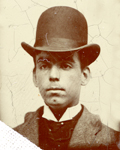
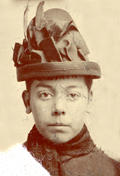
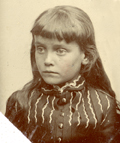
Left: Lindsley Loring (1886, age 15)
Middle: Alice Loring (1886, age 12)
Right: Marjorie Channing Loring (1886, age 9)
Middle: Alice Loring (1886, age 12)
Right: Marjorie Channing Loring (1886, age 9)
These are the three children of Thacher Loring and Margaret Fuller (Channing) Loring. They are direct descendants of William Ellery, a signer of the Declaration of Independence, and their great-grandfather was the fourth dean of Harvard Medical School.
- Lindsley (1871-1956) married Charlotte Blake Cochrane. He held executive positions in several New England chemical companies. They lived in Westwood, MA.
- Alice (1874-1934) married William Lothrop Edwards, a physician. They lived in various locations in Boston's Back Bay. By 1923 they were living at 15 Hereford where they lived until January 1934, the month in which they both died.
- Marjorie (1877-1959) was involved with many charitable organizations. She never married.
[30] Cadwallader Curry, engaged in the wool business and a
Savings Bank Commissioner, built the Stick Style house at 100 High St. (1880). Notice the half-hip dormer, the ornamental slate roof, and the clapboards overlaid with Stick style boarding.
- Pictured here is his son, Sebastian (1874-1951). Sebastian's mother, Mary Abby Lane, was a music teacher. The family moved to Europe in 1890 and Sebastian lived at various times in Switzerland, Italy, and Austria, but primarily in the town of Riederau-on-the-Ammersee, Germany, near Munich, where he was a farmer.
[31] Across High Street is number 99, built in the 1860s for John W. Candler, who was a Representative in the U.S. Congress, as well as a director of the Brookline and Aspinwall Land Companies. There was a great annexation struggle between Brookline and Boston in the 1870s, when Brookline became the first suburb of a major U.S. city to successfully resist annexation by its adjacent core city. Brookline started a national trend, which by the end of the century effectively ended the growth of many U.S. core cities through annexation. Candler was a leader of the losing, proannexation side and, as a result, lost his "safe" Republican seat in Congress. In 1907, the architect F. Manton Wakefield, then its owner, installed alterations which include towers, pointed gables, and a half-timbered facade hat now give the edifice a medieval-Gothic appearance.
There remain several mysteries surrounding the Hall family who lived here, apparently with Candler, in the 1880s. Joseph Thomas Hall and Myra Isabelle (Garrison) Hall were living in Baltimore when their son, Fred Garrison Hall, pictured here, was born in 1879. The last known records for Joseph Thomas Hall are for 1880 in Baltimore; his son, Irving Kent, pictured here, was born in September 1881, so this would indicate that he died in early 1881. The widowed Myra Garrison Hall then leaves Baltimore and moves to John Candler's 99 High St. home. She is listed at 99 High between 1885 - 1889 and subsequently in Cambridge starting in 1892. In 1900, son, Irving Kent, pictured here, is living with her there as he attends Harvard.
There remain several mysteries surrounding the Hall family who lived here, apparently with Candler, in the 1880s. Joseph Thomas Hall and Myra Isabelle (Garrison) Hall were living in Baltimore when their son, Fred Garrison Hall, pictured here, was born in 1879. The last known records for Joseph Thomas Hall are for 1880 in Baltimore; his son, Irving Kent, pictured here, was born in September 1881, so this would indicate that he died in early 1881. The widowed Myra Garrison Hall then leaves Baltimore and moves to John Candler's 99 High St. home. She is listed at 99 High between 1885 - 1889 and subsequently in Cambridge starting in 1892. In 1900, son, Irving Kent, pictured here, is living with her there as he attends Harvard.
- Irving Kent married Helen Macy in 1910 and was employed as a tea merchant in a New York firm run by his wife's father.
- Fred Garrison Hall married Evelyn Orville Ames in 1909 after graduating from Harvard. He was trained as an architect but became an etcher whose works are in museums around the world. His first wife, Evelyn, died in December of 1940. He continued to live in their home at 260 Beacon St., Boston, then married Ariel Perry and moved to 360 Beacon St., Boston.
[31A] 123 High St. was the long time home of Joshua Crane and Annie Eliza (Jose) Crane. His daughter, Mary, married Edward Francis McClennen in 1911. Upon graduation from Harvard Law School in 1895, her future husband joined the law office of Louis Brandeis who later became the first Jewish Justice of the Supreme Court. But their marriage only happened after some significant drama:
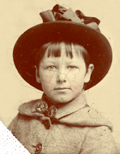
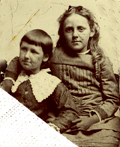
Mary Crane would find herself in the middle of a high-society scandal that was featured in a front-page double-type-headlined article (Boston Post, October 28, 1910). At the time she had been the close friend of Mary Bigelow Young, the wife of Edward McClennen, a prominent lawyer with the well-know law firm of Brandeis, Dunbar & Nutter. When Mrs. McClennen was away, Mary Crane often stayed at the McClennen's house and cared for the children. The McClennens, who had recently completed a custom home at 35 Lakeview Ave., Cambridge, were close friends with Mr. and Mrs. Sawyer, he, a law associate of Mr. McClennen who lived around the corner at 77 Larch Rd. with his then pregnant wife and their two boys. Mary Young McClennen abruptly ran off with Robert Sawyer, and Edward McClennen filed suit for divorce soon thereafter. Mary Crane cared for the children after the elopement and, ten months later, after the divorce was finalized, she and Mr. McClennen married.


Left: Mary Crane, (1886, age 11)
Right: 1886 Mary Crane (left, age 11) with Katherine Putnam Peabody who lived around the corner at 50 Edgehill Rd.
Right: 1886 Mary Crane (left, age 11) with Katherine Putnam Peabody who lived around the corner at 50 Edgehill Rd.
LAWYER ELOPES WITH HIS PARTNER'S WIFE
Robert W. Sawyer, Jr., and Mrs. Edward McClennen, prominent in Cambridge Society, Disappear Together
Both Madly Infatuated With Each Other
Mary Crane would find herself in the middle of a high-society scandal that was featured in a front-page double-type-headlined article (Boston Post, October 28, 1910). At the time she had been the close friend of Mary Bigelow Young, the wife of Edward McClennen, a prominent lawyer with the well-know law firm of Brandeis, Dunbar & Nutter. When Mrs. McClennen was away, Mary Crane often stayed at the McClennen's house and cared for the children. The McClennens, who had recently completed a custom home at 35 Lakeview Ave., Cambridge, were close friends with Mr. and Mrs. Sawyer, he, a law associate of Mr. McClennen who lived around the corner at 77 Larch Rd. with his then pregnant wife and their two boys. Mary Young McClennen abruptly ran off with Robert Sawyer, and Edward McClennen filed suit for divorce soon thereafter. Mary Crane cared for the children after the elopement and, ten months later, after the divorce was finalized, she and Mr. McClennen married.
[32] At 127 High Street is a stucco hipped-roof Arts & Crafts style house designed in 1909 by Edwin Lewis, Jr. for Prescott F. Hall, grandson of Walter Farnsworth, who built 135 High for his daughter. Prescott Hall was a lawyer and prolific writer on such topics as law, economics, and eugenics. Best known for founding the League for Restriction of Immigration, in 1906 he wrote
Immigration and its Effect upon the United States. But he also was involved in progressive housing
reform and helped draft Brookline’s first zoning bylaw.
[32A] Next door at 135 High Street is a large Greek Revival house built for Prescott Hall's father between 1871-74, the large portico being a later addition. The house was updated in 1926 by Edwin J. Lewis Jr., who added the monumental columns, long windows and new entrance. The wrought iron fence once enclosed the entire Hall property. Its circa 1870 barn, at 131 High, became a house about 1940.
[32B] According to local legend, the Italianate house at 138 High Street (ca. 1861) was another station on the underground railway although its apparent construction date, suggests otherwise. This house is one of the earliest to be built in the development of High Street Hill (Pill Hill). It was built by Sarah Searle, a Swedenborgian who was not married, for her own use. It was the home of Dr. Walter Channing at the time of his death in 1876. He was first dean of the Harvard Medical School and a founder of the Boston Lying-In Hospital. In the late 1800s Mrs. Elizabeth Lamb, along with her daughter Augusta and her son Henry lived here. In the 1920s, Henry Whitney Lamb, an industrialist and president of the Brookline Savings Bank who, like several of
his neighbors, was a member of the Anti-Imperialist League, continued to live there.
Edgehill Road
Laid out as Summit Street in 1871, Edgehill Road is one of the most attractive cul-de-sacs in Brookline. As one walks along, notice the landscaping which, in many instances, retains its Victorian character. Perhaps most immediately striking is the diversity of trees, shrubs, and vines which produces subtle blendings and contrasts of foliage color, shape, and texture. The Victorians were as fascinated by the profusion of botanical varieties available in the second half of the nineteenth century as they were with the complexity of architectural patterns. Closer inspection reveals other elements typical of Victorian landscaping-curvilinear design, irregularity to achieve a picturesque quality, and the careful creation of miniature vistas to enhance a feeling of seclusion. "Every walk has a purpose" was the dictum of the Victorian gardener.
Nicknamed "Candler's Jam" (1881), the set of four closely-spaced, Queen Anne
cottages at 17, 19, 25, & 29 Edgehill, was built by Congressman John W. Candler, a
director of the Land Company, as an endowment for an unmarried daughter. Although similar, each has individual features.
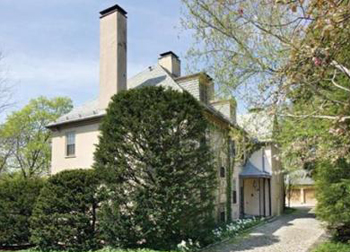
33 Edgehill Rd.
photo courtesy Hammond Residential Real Estate
photo courtesy Hammond Residential Real Estate
[35] Next door, 41 Edgehill Road exemplifies the fashionable practice of altering buildings to contemporary tastes. Here the clapboard mansard-roofed home of Samuel Cabot, which dates to 1870-71, was "Colonial Revivalized" in 1934, with pedimented dormers and doorway, a fanlight, and a round arched window, by Royal
Barry Wills, one of the great popularizers of the Colonial Revival.
[36] The house at 44 Edgehill Road is a brick Queen Anne style structure by Robert Peabody who designed his own house nearby. It was constructed for Peabody's friend and college roommate, Moorfield Storey. In about 1904, he and Peabody both moved to new Peabody-designed houses on the Fenway.
The Storey sisters grew up here with their parents, Moorfield Storey and Ann Gertrude (Cutts) Storey. Storey was a president of
the American Bar Association and the president, for most of its existence, of the Anti-Imperialist League,
an organization founded to oppose the annexation of the Philippines as a colony and to support free
trade and the gold standard. Its members included Jane Addams, Andrew Carnegie, Grover Cleveland,
Mark Twain, Samuel Gompers, and John Dewey, among many notables. Later Storey became the first
president of the NAACP.
- Elizabeth (1871 - 1951), the older sister, led a women's organization in support of French recovery after World War I, an effort that earned her induction into the French Legion of Honor. She aided that country again after World War II. (The Boston Globe, covering a 1947 visit to Normandy, described her as "a regal-appearing great-grandmother, whose fragile exterior appears in great contradiction to her drive, energy, and organizing talent".) She was also a leader in the effort to repeal Prohibition and active in many other civic organizations. Her husband, Robert Williamson Lovett, was a prominent orthopedic surgeon who died in 1924. The couple purchased 7 Fairfield St., Boston in 1901 and lived there until Robert's death.
- Katherine (1879-1920), the younger sister, married Malcolm Donald, a graduate of Harvard Law School who practiced in Boston. They lived in Milton with their two children.
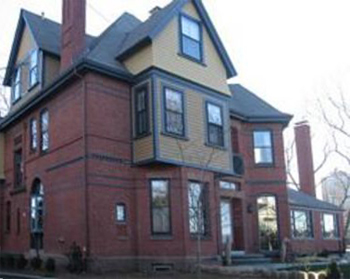
50 Edgehill Rd.
photo courtesy Mass Realty
photo courtesy Mass Realty

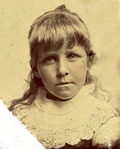
Left: Katherine Putnam Peabody, (right, 1886, age 9) with Mary Crane (left) who lived around the corner at 123 High St.
Right: Mary Derby Peabody (1886, age 5)
Right: Mary Derby Peabody (1886, age 5)
[36A] 50 Edgehill is not visible from the street. It was the house of architect Robert Swain Peabody and Annie Putnam from 1876 - 1903.
- Their daughter, Katherine Putnam Peabody (1877-1955), married William Rodman Peabody in 1908.
- Her younger sister, Mary Derby Peabody (1881-1981) married Henry Russell Scott in 1910. Their grandfather was a minister of King's Chapel, Boston.
[37]
Note also 36 Edgehill Road, a brick and shingle building with half-timbering in the front gable. This stucco and wood patterning typical of late Queen Anne design suggest the renewed interest in English medieval motifs. It belonged to Charles Torrey, an artist who painted ships and nautical scenes.
[38] In 1881 Edward Cabot and Francis Chandler designed the house at 26 Edgehill Road for Samuel Cabot, Jr. Here one sees the turret, diamond paned windows, bays, and the multiple shingle patterns of the period.
[39] 20 Edgehill Road was built in 1884 for Charles Storrow, head of a cotton brokerage firm, and Martha Cabot Storrow. This brick and shingle house was designed by Cabot and Chandler, the former being Martha's father who lived on High Street in the Point. Note the gambrel roof, turret, prominent chimney and eyebrow dormer. Frederick Law Olmsted's landscaping is evident in the pastoral setting-with the heavy stone wall, rolling hills and a quaint stone bridge. It almost seems the very picturesque 20 Edgehill, with its exceedingly odd
assortment of window shapes and sizes, and equally eccentric muntin bar patterns, was meant to
terminate the garden, in the English landscape tradition of the garden "Folly."
[40] Walking down Cumberland Avenue, note the imposing facade of 112 High Street, in contrast to the small stature of its renovated carriage house at 50 Cumberland Avenue. Like 20 Edgehill Road it is a brick and shingle house designed by Cabot and Chandler and built in 1884 for Charles Storrow and Martha Cabot Storrow. It was designed so that a small discrete stage could be created at one end of the parlor and it was used by a neighborhood Shakespeare Club.
Unfortunately, the original John La Farge stained glass windows in the house were sold in the 1970s. It also suffered a kitchen and roof fire at about that time, changing the roof profile on the Cumberland side. Between 112 High and 20 Edgehill is an intensely developed F.L. Olmsted, Sr. landscape that includes a ravine spanned by a stone bridge and hills banked up against a street-edge retaining wall of rough puddingstone boulders, forming a sort of "ha ha" (a one sided wall not visible from inside the property).
Unfortunately, the original John La Farge stained glass windows in the house were sold in the 1970s. It also suffered a kitchen and roof fire at about that time, changing the roof profile on the Cumberland side. Between 112 High and 20 Edgehill is an intensely developed F.L. Olmsted, Sr. landscape that includes a ravine spanned by a stone bridge and hills banked up against a street-edge retaining wall of rough puddingstone boulders, forming a sort of "ha ha" (a one sided wall not visible from inside the property).
Brookline Land Company’s Development Below High St.
Allerton St. was the first part to be built out of the Brookline Land Company’s second plan for
the area east of High. It was initially an oblique extension of Irving St. Set in the Pond Ave. curve at the bottom of Allerton, where the original lower entry to the Land
Company’s unrealized five-acre park was to have been, was the old Ward School. Originally built on
Pearl Place in Brookline Village in 1853, it was enlarged and moved in 1863 to this Land Company site.
(Buildings were moved routinely in frugal nineteenth century New England; there is an entire street of moved cottages in the Point neighborhood.) In 1888 the school was razed, being deemed incompatible
with Olmsted’s design for the Emerald Necklace. The present Allerton Overlook, as Olmsted’s design
referred to this site, was recently restored in memory of Louise Castle, Pill Hill resident and Brookline’s
first Selectwoman.
Eventually, the Land Company coordinated its plans with those Olmsted drew up for the Muddy River Improvement, now part of the Emerald Necklace — although Olmsted’s first Brookline park plans date only from 1880, well after the Land Company’s second subdivision plan for this area had been laid out by Ernest Bowditch. Eventually, in the 1890s, the Company sold to the town much of what became Olmsted Park, Leverett Pond, and Riverdale Parkway (a former pleasure drive where the bicycle and pedestrian paths are now). One reason this part of the neighborhood was slow to develop is that, before Olmsted’s improvements, the brackish tidewaters of the fetid Back Bay reached as far as the present Leverett Pond.
[41]
One could easily be misled by number 47 across the street. It was designed in 1928 by Kilham, Hopkins and Greely in imitation of seventeenth and eighteenth century colonial homes.
[41A]
A Pill Hill institution is the clay tennis court at the corner of Hawthorn and Cumberland. By
1893, far earlier than for much of that area, there was already a house on that lot, owned by E.W. Lamb.
By 1907 the house had been replaced by a carriage house or "barn", designed by Peabody & Stearns,
and still owned by Lamb. Curiously, the barn (as shown on town atlases) appeared to have the same
footprint as the house, but was located further up the Cumberland side of the lot. In the 1920s it
belonged to Mrs. Redmond, who lived at 70 Upland. Mrs. Redmond, whose daughter was an
accomplished equestrian, kept a horse in her Cumberland Ave. barn. It was also rumored, perhaps
apocryphally, to have been a Prohibition era depository of bootlegged hooch. In 1930 she sold the lot for $10,500 to The Hawthorne Associates Trust. By then the tennis court was already in place. The
Trust’s shareholders were a broad group of neighbors who may have been more concerned about
inappropriate development than about tennis. At that time and for some years thereafter the barn was
used to store stage scenery for the Leland Powers School of the Spoken Word and to garage
automobiles. The tennis court was leased to an informal neighborhood club. Sometime in the 1940s the
trust considered subdividing the lot and selling the part with the barn, which has been recalled as being
built of brick and stone, for conversion into a house. However a zoning change precluded that. In the
mid-50s the barn was demolished. At some point the Trust took over the role of the tennis club. It also
gradually gained control of a majority of the shares, although some are still handed down from owner to
owner when houses are sold. Anyone living in the neighborhood can be a playing member of the club.
[42] At the eastern base of Pill Hill stands the Boston Free Hospital for Women. The major hospital building abutting the Muddy River (part of the Olmsted Park System National Register District) was built in 1895 by Shaw and Hunnewell. Trimmed in limestone, details include string coursing, arched windows, carved keystones and an unusual motif of diamond shaped carved lions' heads. A bracketed cornice, gables and copper dormers in the wings add to the richness of detail. Though less ornate, the other buildings and rear wing echo the main structure's design. The hospital is historically significant as the first teaching hospital for Harvard and as the first hospital in the country to apply radiation treatment for cancer. The landscaping was tended by Charles Sprague Sargent, director of the Arboretum for 54 years. Like Olmsted, Sargent lived near Pill Hill at his estate "Holm Lee".
[43] Hawthorn (originally Hill St.) and Glen roads, perpendicular to Cumberland Avenue, were laid out by the Brookline Land Company in the early 1870s. Compare their grid pattern to the picturesque, winding quality of Upland or Edgehill roads. Numbers 17 and 21 Hawthorn Road are a pair of Federal Revival style clapboard buildings designed by Peabody and Stearns in 1893. Note the quoins, the dentilled cornices on windows and roof, the extremely shallow roof and the small third floor windows above the projecting horizontal course.
[44] 14 Hawthorn Road was designed by Ball & Dabney and constructed, in 1896, by the builders Whidden and Company. Its owner was Thomas Aspinwall who built the house, at a reduced scale, as a near copy of his great grandfather's 1803 Federal style house on Aspinwall Hill. The house is Georgian Revival with its Palladian and lunette window decoration, Doric columns and balustraded entrance.
[45] Next door at number 4 is an unusual two-color, brick, Georgian Revival, that was built for Mrs. Charles Appleton, in 1894, based on
the designs of Henry F. Bigelow and William Rutan. Later, it was owned by Charles S. Sergeant, an
executive of the Boston Elevated Railway Company. His daughter Katharine was a long-time editor of
the New Yorker, mother of writer Roger Angell, and wife of E.B. White.
[46] Turning onto Allerton Street, originally a continuation of Irving Street, one views a variety of Queen Anne and Colonial Revival style homes from the 1880s and 1890s. 58 Allerton Street was designed in 1899 by Joseph E. Chandler, the restorationist of the Paul Revere House. Thus, it is no accident that this box-like, hipped-roof building was constructed in the Georgian Revival style.
Roland Hayes, the world-renowned opera singer and pioneering African-American artist, lived at 58 Allerton for fifty years until just before his death in 1977. He was the son of former slaves from Georgia and was the first to conquer many barriers to African-Americans in the world of classical music. He eventually became the highest-paid tenor in the world.4
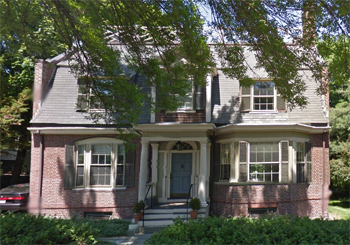
52 Allerton Street
courtesy Google Maps
courtesy Google Maps
[46B]
Charles Knowles Bolton and Ethel (Stanwood) Bolton married in 1897, lived on nearby Upland Rd. and, in 1906, moved to the "cottage" type house at 48 Allerton (1893, designed by William F. Goodwin). Ethel (1873 - 1954), who grew up at 76 High St., was the compiler of the two photo albums from which most of the images of Pill Hill children in this tour are drawn. She graduated from Wellesley College in 1894 and married Charles Knowles Bolton in 1897. She was a Registrar for the Massachusetts Society of the Colonial Dames, authored books and articles about local history, and was an amateur artist.
Her husband, the author of Brookline, The History of a Favored Town and other books and a founder of the Brookline Historical Society was Librarian of the Brookline Public Library from 1893-1898, and spent the remainder of his career as Librarian of the Boston Athenaeum.
Other references:
[46C]
41 Allerton was built in 1896 by the firm of Chapman & Fraser and was the longtime home of the Dana family. Gorham Dana (born 1868) was a trustee of the Historical Society, active in the community, and authored publications on Brookline taverns and the dangers of wood triple-deckers. He was knowledgeable about fire prevention methods and fought the construction of triple-deckers.
[46D]
35 Allerton (1892) was designed by the firm of Walker & Kimball. The Flint family, described at the top of the page, had been living in the Edward Philbrick property at 205 Walnut St. In 1892-93 they moved to 35 Allerton. This included: the widow of Edward Austin Flint, Lucy Whitwell Parker Flint; her widowed mother, Lucy C. Parker; son, John Flint, a student at Harvard; and daughter, Sarah G. Flint, age 16.
[46E]
Judith Eleanor Motley Low lived at 28 Allerton (1884), the house with the little pepper-pot turret. As a 60-year old widow she founded the Lowthorpe school of Landscape Architecture in Groton Mass. in 1901, the first such school intended to prepare women as professionals. In 1945 it merged into the Rhode Island School of Design and became the basis of RISD’s Landscape Architecture Department. After Ms. Low, 28 Allerton was the home of Dr. John Rock. He developed the oral contraceptive Pill at the Free Hospital for Women — thus, perhaps, singlehandedly justifying the name "Pill Hill."
[47] On the corners of High and Allerton are two houses which exemplify the eclectic Victorian and the Classical Revival traditions of Pill Hill's development. 68 High Street is a stone and shingle mansard built in 1871 by the fashionable Boston firm of Snell & Gregerson for Henry Sayles, one of the first directors of the Brookline Land Company. The complexity of the roof and the mixture of materials display Queen Anne elements, while the stick decoration in the pointed windows reflect earlier stylistic influences.
[48] Across the street at number 60 is an accurate eighteenth century reproduction designed in 1928 by the firm of Howe, Manny and Almy. Lois Lilley Howe and Eleanor Manning O’Connor were among the first women graduates
of the M.I.T. School of Architecture. Their firm was the first all-woman architecture practice in Boston
and the second in the U.S. They built over thirty houses in Cambridge and public housing in Boston.
Howe was the first woman elected a Fellow of the American Institute of Architects. The house was built for William
C. Codman. The classical architectural details of the quoining, window framing and entrance pilasters have been carefully retained in the application of aluminum siding.
[49] In contrast to the complex massing and textural combination of the mansard structure at 68 High Street, observe the solid vertical quality of the earlier Second Empire style building at 52 High Street. It was built in 1864 and soon occupied by Michael Quinlan, whose carriage works was down in the village (where the Dunkin Donuts is now).
[50] Around the corner is 103 Walnut Street, the oldest house on Pill Hill and one of the oldest surviving houses in Brookline. Built in 1798, it is a typical vernacular Federal style house with its simple ridge roof, two low chimneys, symmetrical fenestration, cornerboards on a clapboard structure, and a simple dentil course. The entrance porch is a later addition with its fluted pilasters and sidelights.
In 1816, Elyphalet Spurr, the builder and original owner, established the first line of coaches to run between the Punch Bowl Tavern in Brookline Village and Boston. It lasted only a few years, in part because the fares were considered too high. In 1817, Thomas and Eliza Aspinwall, the son and daughter of Colonel Thomas Aspinwall, purchased it. Thomas was deaf mute but was active in the town, making himself understood by signs. He and his sister died within a year of each other in the early 1840s. From 1868 to 1877, the house was the Massachusetts Infant Asylum, a private institution that provided care and placement for deserted infants. It has sometimes been described as the first foundling hospital in the United States. The institution moved to West Roxbury and 1877 and later merged with the Boston Children's Aid Society.
[Editor's Note This house is profiled in Nina Fletcher Little's book, Some Old Brookline Houses.]
In 1816, Elyphalet Spurr, the builder and original owner, established the first line of coaches to run between the Punch Bowl Tavern in Brookline Village and Boston. It lasted only a few years, in part because the fares were considered too high. In 1817, Thomas and Eliza Aspinwall, the son and daughter of Colonel Thomas Aspinwall, purchased it. Thomas was deaf mute but was active in the town, making himself understood by signs. He and his sister died within a year of each other in the early 1840s. From 1868 to 1877, the house was the Massachusetts Infant Asylum, a private institution that provided care and placement for deserted infants. It has sometimes been described as the first foundling hospital in the United States. The institution moved to West Roxbury and 1877 and later merged with the Boston Children's Aid Society.
[Editor's Note This house is profiled in Nina Fletcher Little's book, Some Old Brookline Houses.]
[51] Descending to the commercial center of Brookline Village one is struck by the contrast between the several buildings representing different periods of growth for the Town. On the left is the brick and sandstone "Hotel" Adelaide from the 1870s whereas on the right are the urban renewal efforts of the sixties. In light of the development pressures in this area, it is indeed fortunate that so much of Pill Hill's Victorian architecture remains intact.
[1] The Pill Hill Local Historic District: The Story of a Neighborhood Brookline Preservation Commission, Dennis De Witt, Roger Reed, & Greer Hardwick, 2009
[2] The Second Empire style and its origins are discussed at the beginning of the Aspinwall tour Aspinwall tour
[3] Vincent J. Scully, The Shingle Style and the Stick Style (New Haven: Yale University Press, 1974), p. xlvi.
Other references:
- National Register Of Historic Places Inventory -- Nomination Form Aspinwall tour
© 1977 Brookline Historical Commission
© 2009 Brookline Preservation Commission. All rights reserved.
© 2015 Brookline Historical Society
© 2009 Brookline Preservation Commission. All rights reserved.
© 2015 Brookline Historical Society
